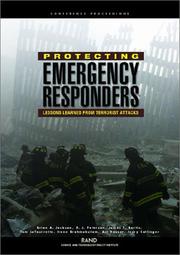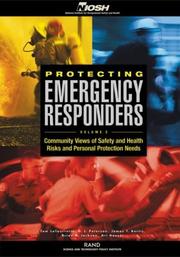| Listing 1 - 6 of 6 |
Sort by
|
Book
Year: 2005 Publisher: Santa Monica, CA : RAND Corporation,
Abstract | Keywords | Export | Availability | Bookmark
 Loading...
Loading...Choose an application
- Reference Manager
- EndNote
- RefWorks (Direct export to RefWorks)
Following the collapse of the World Trade Center towers on September 11, 2001, a complicated mixture of pulverized building material and combustion by-products was released at the collapse site and into surrounding areas of New York City. In the months following, several federal agencies monitored the air, dust, and water, testing for hundreds of substances. In addition, many workers were treated for symptoms that resulted from exposure to these substances. In an effort to help develop federal guidelines for personal protective equipment used by emergency responders, this report summarizes data on injuries among emergency responders available from incidents of structural collapse (including the World Trade Center in 2001 and Oklahoma City's Murrah Building in 1995), reviews the possible health effects of substances likely to be found in pulverized building materials, and describes the possible health effects of several combustion by-products. For each substance analyzed, the report details the substance's identity, properties, and uses; possible routes of exposure; evidence for health effects from human studies; occupational exposure limits; and carcinogenicity status.
Hazardous substances --- Chemicals --- Environmentally induced diseases. --- Toxicology. --- Building failures --- Structural failures --- Emergency medical personnel --- Protective clothing --- Hazardous Substances. --- Emergencies. --- Environmental Exposure. --- Health aspects. --- Health and hygiene. --- Standards.

ISBN: 1283597276 9786613909725 0833032577 083303149X 9780833032577 9780833031495 9781283597272 6613909726 Year: 2002 Publisher: Santa Monica, Calif. Rand
Abstract | Keywords | Export | Availability | Bookmark
 Loading...
Loading...Choose an application
- Reference Manager
- EndNote
- RefWorks (Direct export to RefWorks)
Based on a 2001 conference held in New York City that looked at ways of improving health and safety for emergency workers who respond to terrorist attacks. It is intended for managers and decisionmakers to help them understand the working and safety environment associated with such attacks.
Community Networks. --- Disaster relief. --- Emergency management. --- Emergency medical personnel. --- Emergency Medical Technicians. --- Emergency medicine. --- Employees. --- Employees - Safety measures - Congresses. --- Fire fighters. --- Industrial safety. --- Industrial safety - Congresses. --- Police. --- Protective clothing. --- Risk assessment. --- Safety. --- September 11 Terrorist Attacks, 2001. --- Protective clothing --- Industrial safety --- Employees --- Engineering & Applied Sciences --- Social Welfare & Social Work --- Social Sciences --- Technology - General --- Social Welfare & Social Work - General --- Safety measures --- Laborers --- Personnel --- Workers --- Clothing, Protective --- Personal protective equipment --- Safety clothing --- Persons --- Industrial relations --- Personnel management --- Clothing and dress --- PPE (Personal protective equipment) --- Survival and emergency equipment --- Equipment and supplies --- Personal protective equipment.
Book
ISBN: 9073782724 Year: 1997 Publisher: Leiden Research School CNWS
Abstract | Keywords | Export | Availability | Bookmark
 Loading...
Loading...Choose an application
- Reference Manager
- EndNote
- RefWorks (Direct export to RefWorks)
Ethnology. Cultural anthropology --- Sami --- costume [mode of fashion] --- Inuit [Canadian Arctic Native style] --- Greenland --- Siberia --- Arctica --- Clothing and dress --- Cold weather clothing --- Inuit --- Clothing --- 830 Economie --- 842 Media --- 846 Identiteit --- 884.1 Oost-Europa --- Innuit --- Inupik --- Eskimos --- Arctic clothing --- Clothing, Cold weather --- Protective clothing --- Apparel --- Clothes --- Clothing and dress, Primitive --- Dress --- Dressing (Clothing) --- Garments --- Beauty, Personal --- Manners and customs --- Fashion --- Undressing --- Personal protective equipment
Periodical
ISSN: 0436029X 19884168 Year: 1961 Publisher: Kalundborg, Danemark : Madrid : Gladius, Consejo Superior de Investigaciones Científicas
Abstract | Keywords | Export | Availability | Bookmark
 Loading...
Loading...Choose an application
- Reference Manager
- EndNote
- RefWorks (Direct export to RefWorks)
Weapons --- Armor --- Military art and science --- Armes --- Armures --- Art et science militaires --- Periodicals. --- Périodiques --- Armor. --- Military art and science. --- Weapons. --- Périodiques --- DOAJ-E EPUB-ALPHA-G EPUB-PER-FT --- military history --- war history --- polemology --- archaeology --- armaments --- armies --- Weaponry --- Weapons, Primitive --- Implements, utensils, etc. --- Tools --- Fighting --- Military power --- Military science --- Warfare --- Warfare, Primitive --- Naval art and science --- War --- Armor, Primitive --- Armour --- Suits of armor --- Protective clothing --- Arms and armor --- Personal protective equipment

ISBN: 0833036033 1417506687 083303295X 9781417506682 9780833036032 9780833032959 Year: 2003 Publisher: Santa Monica, CA Rand, Science and Technology Policy Institute
Abstract | Keywords | Export | Availability | Bookmark
 Loading...
Loading...Choose an application
- Reference Manager
- EndNote
- RefWorks (Direct export to RefWorks)
Firefighters, law enforcement officers, and emergency medical service responders play a critical role in protecting people and property in the event of fires, medical emergencies, terrorist acts, and numerous other emergencies. The authors examine the hazards that responders face and the personal protective technology needed to contend with those hazards. The findings are based on in-depth discussions with 190 members of the emergency responder community and are intended to help define the protective technology needs of responders and develop a comprehensive personal protective technology re
Emergency medical personnel. --- Employees--Safety measures--Congresses. --- Industrial safety--Congresses. --- Protective clothing. --- Accident Prevention --- Risk --- Epidemiologic Measurements --- Risk Management --- Allied Health Personnel --- Medicine --- Disasters --- Probability --- Organization and Administration --- Environment --- Health Occupations --- Public Health --- Accidents --- Health Personnel --- Emergency Medical Technicians --- Risk Assessment --- Safety --- Emergency Medicine --- Rescue Work --- Statistics as Topic --- Environment and Public Health --- Health Care Facilities, Manpower, and Services --- Occupational Groups --- Health Services Administration --- Disciplines and Occupations --- Persons --- Health Care --- Epidemiologic Methods --- Health Care Evaluation Mechanisms --- Quality of Health Care --- Investigative Techniques --- Named Groups --- Analytical, Diagnostic and Therapeutic Techniques and Equipment --- Health Care Quality, Access, and Evaluation --- Health & Biological Sciences --- Emergency Medical Services --- Emergency medical personnel --- Fire fighters --- Police --- Safety measures. --- Cops --- Gendarmes --- Law enforcement officers --- Officers, Law enforcement --- Officers, Police --- Police forces --- Police officers --- Police service --- Policemen --- Policing --- Firefighters --- Firemen --- Medical emergency personnel --- Legal status, laws, etc. --- Criminal justice, Administration of --- Criminal justice personnel --- Peace officers --- Public safety --- Security systems --- Fire departments --- Emergency medical services --- Emergency medicine --- Medical personnel --- Officials and employees
Book
ISBN: 3036560815 3036560823 Year: 2022 Publisher: Basel MDPI - Multidisciplinary Digital Publishing Institute
Abstract | Keywords | Export | Availability | Bookmark
 Loading...
Loading...Choose an application
- Reference Manager
- EndNote
- RefWorks (Direct export to RefWorks)
PART 1. Functional Textiles: Photochromic Textiles Based upon Aqueous Blends of Oxygen-Deficient WO3-x and TiO2 Nanocrystals. 50/60 Hz Power Grid Noise as a Skin Contact Measure of Textile ECG Electrodes. Characterizing Steam Penetration through Thermal Protective Fabric Materials. Stretchable Textile Yarn Based on UHF RFID Helical Tag. Fibers and Textiles for Personal Protective Equipment. Textile-Based Sound Sensors (TSS). High-Performance and Functional Fiber Materials. Geotextiles—A Versatile Tool for Environmental Sensitive Applications in Geotechnical Engineering. Review of Fiber- or Yarn-Based Wearable Resistive Strain Sensors. Wearable Actuators: An Overview. Bacterial Secondary Metabolites as Biopigments for Textile Dyeing. PART 2: Process and Modelling. Loop Order Analysis of Weft-Knitted Textiles. New Geometrical Modelling for 2D Fabric and 2.5D Interlock Composites. Meso-Macro Simulations of the Forming of 3D Non-Crimp Woven Fabrics. Continuous Yarn Electrospinning. A Review on Tough Soft Composites at Different Length Scales. Textile Branch and Main Breakthroughs of the Czech Republic in the Field of Textile Machinery. Recent Efforts in Modeling and Simulation of Textiles. PART 3: Control. A Comparison of Two Different Light Booths for Measuring Color Difference of Metameric Pairs. Effect of Textile Characteristics on the AR-Glass Fabric Efficiency. Dielectric Properties of Textile Materials. PART 4: Consumers and Behavior. Development of a Consumer-Based Quality Scale for Artisan Textiles. Organic Cotton Clothing Purchase Behavior. A Review on Textile Recycling Practices and Challenges.
Business strategy --- Manufacturing industries --- smart textiles --- wearable --- fiber actuators --- soft exoskeleton --- haptic action --- textile modeling --- homogenization --- beam-based model --- buckling --- folding --- spacer fabrics --- organic cotton --- clothing --- consumer behavior --- Theory of Reasoned Action --- alkali-resistant glass textile --- weaving --- epoxy coating --- filament diameters --- roving fineness --- fabric efficiency --- textile-reinforced concrete --- TRC --- fabric-reinforced cementitious matrix --- FRCM --- textile development --- human and civilization factors --- clothing and technical textiles --- open end spinning --- jet looms --- perpendicularly layered nonwovens --- needleless electrospinning --- textiles --- quality --- artisan --- fabrics --- women in textiles --- soft composite --- mechanical property --- toughness --- toughening mechanism --- fabrication --- application --- helical RFID tag --- helical antenna --- RFID --- textile yarn --- light booth --- metameric pairs --- visual assessment --- gray scale --- standard deviation --- CAM02-UCS --- color difference formula --- thermal protective fabrics --- steam exposure --- fabric properties --- heat and mass transfer --- burn injuries --- textile materials --- complex relative permittivity --- effective medium approximation --- dielectric mixture theory --- electromagnetics --- dielectric characterization --- resistive strain sensor --- fiber-based sensor --- yarn-based sensor --- interconnection --- forming simulation --- multi-scale analyses --- RVE --- hyperelasticity --- thick reinforcements --- nanofibers --- PAN --- cellulose acetate --- biopolymers --- spider silk --- silk fibroin --- 2D fabric --- 2.5D --- interlock composite --- compliance matrix --- textile waste --- reuse and recycling --- municipal solid waste --- composting --- sustainability --- geotextiles --- natural fibers --- synthetic fibers --- geo-engineering --- environmental applications --- high-performance fibers --- functional textiles --- metallized textiles --- inorganic fibers --- Scanning Electron Microscopy (SEM) --- Electron Dispersive Spectroscopy (EDS) --- microbial pigments --- bacterial pigments --- textile --- fibers --- dyeing --- electrocardiogram (ECG) --- Arduino --- electrodes --- conductive coating --- conductive yarn --- sensor --- knitted textiles --- topological modeling --- contact neighborhood --- loop order analysis --- precedence rule --- visualization --- e-textiles --- textile-based sound sensors --- sound monitoring --- smart building --- personal protective equipment --- protective clothing --- special textile structures --- smart textile --- photochromism --- inorganic nanoparticles --- n/a
| Listing 1 - 6 of 6 |
Sort by
|

 Search
Search Feedback
Feedback About UniCat
About UniCat  Help
Help News
News